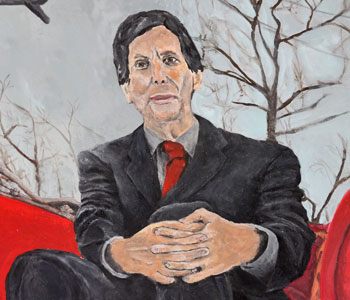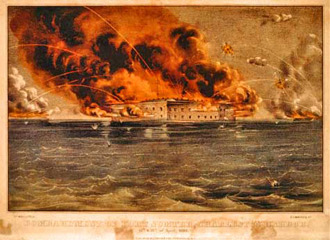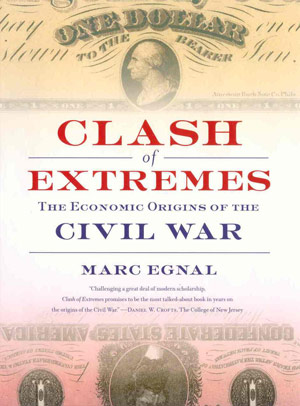
Clash of Extremes presents a new interpretation of the causes of the Civil War. If the prevailing explanation can be summarized in one word, “slavery,” the argument in my book comes down to “economics.”
I tackled the Civil War because I felt slavery just didn’t explain why the sections clashed. For example, the Republican Party, which emerged in the 1850s, made clear it would not disturb slavery where it existed. Nor did Abraham Lincoln’s party oppose the Fugitive Slave Law or call for emancipation when war broke out. In the South, most whites reviled abolitionists, but opposed secession during the winter of 1860 and ‘61. The Border States would remain in the Union, while the Upper South left only once fighting erupted in April 1861. Even in the Deep South, perhaps half the whites resisted immediate secession. A focus on slavery also does not shed light on the earlier period; between 1820 and 1850 the North and South cooperated with each other, although Northerners denounced bonded labor and Southerners defended the institution.
The evolution of the Northern and Southern economies better explains the events of these years. Between 1820 and 1850 the national economy kept the sections together despite disagreements over slavery. The Mississippi River and its tributaries formed a powerful north-south axis. High returns from cotton, fresh soils, and the assistance of the federal government in obtaining new territories persuaded Southerners to value the Union. The two great parties that formed in this era—the Whigs and the Democrats—divided along lines of wealth while sharing a belief in a unified nation.
After 1850 this picture changed. The rapid growth of a transportation system based on the Great Lakes and the Erie Canal reoriented the trade of the northern part of the North. The spread of antislavery only heightened sentiments in that area. In the South, the declining profitability of cotton and diminished prospects for new land led many to question the value of remaining part of the United States. The opposition to further compromise was greatest at the extremes: the northern part of the North and the southern part of the South. Hence the book’s title: Clash of Extremes. In contrast to the Deep South, the slave states more involved in the growing overland trade with the prosperous North proved reluctant to sever ties.
The changing economy, along with the growth of antislavery, fostered new political alignments. Voters living near the Lakes and in New England came together to form the Republican Party. This party was more concerned with promoting economic development than with fighting slavery. In the South a new militant Democratic Party emerged and in 1860 ran its own candidate, John C. Breckinridge. After the outbreak of war, as before, the Republicans focused more on their economic program than on helping African Americans. This imbalance—economic development, first; assistance to blacks, second—continued during Reconstruction.
“The Republican Party was more concerned with promoting economic development than with fighting slavery.”
Several principles shape the book. First, the story of the coming of the Civil War and its aftermath is told with a focus on individuals. Readers will encounter lawmaker Thaddeus Stevens, hobbled by clubfoot and with his red wig askew, frantically trying to stop the disenfranchisement of blacks in the Pennsylvania legislature. They will meet Dixon Lewis, who weighed over 400 pounds, campaigning for states rights at Alabama crossroads towns. They will also get to know women like Abigail Kelley, who had to harden herself to the abuse she received as she went door to door in Lynn, Massachusetts, collecting signatures on antislavery petitions. Clash of Extremes also highlights African-Americans, like Frederick Douglass, and common folk, like Woodson May, an Alabama shingle maker.
There is no contradiction between a book that examines trends in the economy and society and a focus on individuals. Just the opposite. Any explanation of broader changes makes sense only if it also works on the personal level. Lincoln remarked (in discussing his decision to favor emancipation), “I claim not to have controlled events, but confess plainly that events have controlled me.”
Individuals did more than reflect larger developments; they also helped shape them. John C. Calhoun’s forthright defense of Southern rights influenced his many followers. Stephen Douglas’s Kansas-Nebraska Act precipitated divisions within the North and the formation of new parties. A focus on individuals illuminates the society in which they functioned and the conditions that made their accomplishments possible. Many in the Deep South eagerly embraced Calhoun’s views because they too feared that the cotton economy could not secure new soils within a Union dominated by the North. Douglas’s initiative brought into the light divisions within the North that had been present for several years.
Second, while Clash of Extremes concludes that economics was the most important single concern shaping politics, it also examines a broad range of other factors. The growth of antislavery had a noteworthy impact on the outlook of Northerners. Religion, place of birth, and national origins were also significant. For example, New England Congregationalists who settled in the Midwest often favored antislavery parties. By contrast, those who moved from the slave states to the North remained more sympathetic to the Southern cause. Similarly, settlers who migrated from the Appalachian highlands to the Deep South supported the Union more than did their neighbors who hailed from South Carolina and Georgia.
Finally, in examining the impact of economic self-interest on individuals, Clash of Extremes emphasizes the mediating role of ideology rather than short-term calculations. Few individuals chose sides in the sectional dispute simply to put dollars in their purses. For the elite, ideology might have involved elaborate treatises. But for the common folk, ideology often meant a party platform that spoke to their broader interests.
Here are my suggestions for browsing Clash of Extremes. Begin with the Introduction: it provides a brief overview and roadmap for the rest of the book. Then take a look at Chapter 4, “Rise of the Lake Economy.” It’s right at the heart of the changes that transformed the North. It’s a chapter filled with portraits of the important, colorful individuals who spoke for the districts near the Great Lakes. Among those featured are Joshua Giddings, “Long John” Wentworth (one of the few lawmakers taller than Lincoln), Benjamin Franklin Wade, and Lewis Cass. The chapter also discusses the emergence of a peculiarly Northern strand of “nationalism”—a belief that “what’s good for the North is good for the entire nation.” That self-serving philosophy would guide the Republicans in the decades after 1860.
Clash of Extremes is an economic interpretation that takes antislavery very seriously. The fifth chapter, “The Campaign Against Slavery,” portrays such activists as William Lloyd Garrison, Salmon Chase, Charles Sumner, and Gerrit Smith. These pages explore why such crusaders had only a limited impact on the North and why moral concerns remained subordinate to economic ones.
After that, if you are still browsing, explore topics that you find intriguing. You might examine Andrew Jackson’s role in party formation (Chapter 1); follow the activities of Robert Barnwell Rhett in leading the campaign for secession (Chapter 10); or see how Ulysses Grant handled the battle against Klan violence (Chapter 13).

“A belief that “what’s good for the North is good for the entire nation” would guide the Republicans in the decades after 1860.”
Among the joys of writing Clash of Extremes—an undertaking that took more than a dozen years—were the exchanges I had with other historians. I am grateful to the many individuals who read the manuscript and provided carefully reasoned critiques. I’ve brought some of that dialogue into the text, for example in discussions of the arguments about the relative importance of antislavery and economics in shaping the North, and in an examination of the various reasons—including the defense of slavery, hysteria, and the breakdown of parties—that scholars have put forth to explain secession.
That dialogue continues. Hence I’ve established a website that readers are invited to visit: www.clashofextremes.com. It provides links to all the reviews, blogs, podcasts, and videocasts dealing with my book. It also includes my response to several of the critiques set forth since the book’s publication.


Marc Egnal is a professor of history at York University in Toronto, Canada. He was born in Philadelphia, and educated at Swarthmore College and the University of Wisconsin-Madison. He has written three books in addition to Clash of Extremes: A Mighty Empire: The Origins of the American Revolution (Cornell University Press, 1988); Divergent Paths: How Culture and Institutions Have Shaped North American Growth (Oxford University Press, 1996); and New World Economies: The Growth of the Thirteen Colonies and Early Canada (Oxford University Press, 1998). In 2010 Cornell will reissue A Mighty Empire with a new preface.